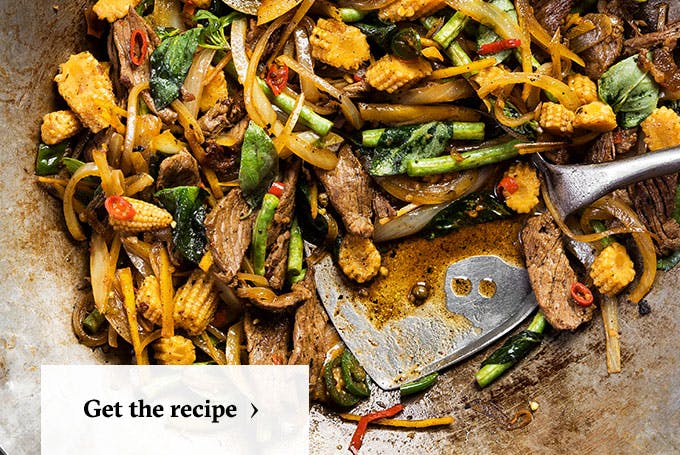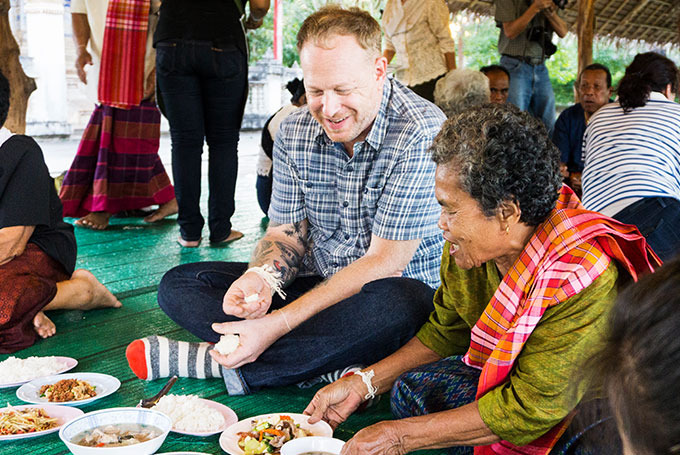Andy Ricker's Travel Guide To Thailand
Follow Pok Pok's Andy Ricker for an insider's guide to Thailand
"By starting to get into the food, I was able to start to understand the culture around me, and that's been my journey," Andy Ricker, chef and owner of the Pok Pok empire, tells me about his 25-year love affair with Thailand. We're throwing back a few beers in the middle of a rice paddy in Chiang Mai, the city he calls home for part of the year. It's day six of an almost two-week-long journey eating and drinking our way through this stunning country.
Wandering through street markets later that afternoon to pick up snacks to enjoy with more beer, Ricker says, "There is no drinking without food and vice versa." Fittingly, his forthcoming cookbook, Pok Pok Drinking Food of Thailand: A Cookbook, which comes out this fall, is all about Thai drinking culture. Later, we'll try lao khao, a rice whiskey, mixed with Coke—another favorite beverage.
The key part of Thai drinking food is that "it's gotta be something a drunk motherfucker could cook himself," Ricker says. One classic example is phat khii mao, which we all know as drunken noodles. But Ricker explains that phat khii mao wasn't always a greasy noodle dish. Originally, this dish was a vibrant stir-fry perfumed with chiles and galangal, and packed with vegetables and beef (see the recipe).
Ricker is, of course, full of backstories and insider tips like this when it comes to Thai food and drinks, which is why our trip—which goes from Bangkok to Chiang Mai before veering to the northeastern region of Isaan and finishing up down south in Phuket—is so invigorating.
Here are the highlights to guide you through this culinary hot spot or to inspire you in your own kitchen at home.
Bangkok
The cuisine of central Thailand is probably the closest to what you'll find in most restaurants in the U.S. Thai food is always a combination of sweet, salty, sour and spicy, but in cities like Bangkok, the curries and noodle dishes will runner sweeter than in other regions. In addition to street food, in Bangkok, you'll also find unique restaurants taking Thai food to an elevated level.
Breakfast: Check out On Lok Yun to see a Thai interpretation of Western breakfast, including wok-fried French toast and ham and eggs.
Lunch: The Never Ending Summer offers dishes such as chile and kaffir lime fried chicken wings and vibrant duck curry in a loft space overlooking the river.
Dinner: Bo.Lan combines super-traditional curries with a focus on high-quality ingredients and technique. The refined menu is constantly changing, and it even has a few Thai wines from the north if you want to try something new.
Chiang Mai
As you travel north to Chiang Mai, you'll begin to see the transition in flavors from sweet to predominantly sour, with an addition of funkiness from fermented fish sauces and pastes. Chiang Mai is also known for the popular dish khao soi, an egg noodle dish served in a rich curry broth with a bright-yellow hue, thanks to turmeric. It's originally a Muslim Chinese dish, and it made its way down to the north of Thailand.
Photo: Tasting Table
Breakfast: Walk the morning markets where you can stop almost anywhere for a cheap but incredibly delicious bowl of tom yum, a noodle soup packed with pork, pork balls, fish balls and rice noodles in a rich pork broth.
Lunch: Stick to noodles and try the regional specialty of khao soi, which you can find everywhere. (We got very lost trying to find Ricker's favorite spot for this dish, off the beaten path in Chiang Mai. But when we arrived, the owner was cutting fresh egg noodles, which is always a good sign.)
Dinner: The night markets behind Chiang Mai University are incredibly lively. Choose from any of the stalls lined up next to one another serving laab, a spicy mixture of finely chopped meats eaten in lettuce cups with fresh herbs.
Phuket
Southern cuisine can be the spiciest in the country. With coconuts growing in this tropical climate, you're going to find rich coconut milk-based curries often packed with fresh seafood.
Breakfast: Pick up some hor mok pla, a Thai curry fish custard steamed in a banana leaf. It takes eggs for breakfast to a new level.
Lunch: Try to get your hands on some blue rice, dyed with butterfly pea flower. Don't be scared off; it's perfect for enjoying with a rich coconut curry.
Dinner: Mor Mu Dong offers traditional summer crab curries and whole fried fish with kaffir lime and lemongrass, all which you'll eat while dining on a mat in a bamboo hut. Finish your meal with drinks at the Blue Elephant, which doubles as a cooking school during the day.
Whether you stick to this plan or go off the beaten path, everything you eat or drink is going to be to Thai for.
Pack your passport—and an appetite—as we hit the world's hottest culinary destinations on and off the grid all month long. Now Boarding: your next trip to paradise.
The Never Ending Summer in Bangkok adds Thai flair to chicken wings, frying them up with kaffir lime leaves, chiles and fresh green peppercorns.
The spread at On Lok Yun, which serves up an interpretation of a Western breakfast.
A street market vendor fries fish paste balls. They're salty, crisp and delicious.
Andy Ricker guides me through a street-side market on our way through the mountains to Chiang Mai.
A common snack in Thailand are these sheets of rice paper speckled with sesame seeds and topped with dried shrimp, fresh chiles, roasted peanuts and herbs.
Ricker, picking up sticky rice snacks in the market. Each one is wrapped in a banana leaf in a different shape to distinguish the filling.
The best breakfast you can get is a big bowl of tom yum noodle soup. Packed with rice noodles, pork broth, roasted pork, and pork and fish balls, it's filling and comforting.
An array of fresh Thai fruit, including papaya, dragon fruit and wax apple, which is shaped like a pear and custardy in texture.
A roadside noodle shop owner in Chiang Mai tosses fresh egg noodles before building a bowl of khao soi.
Native to the north, khao soi has Chinese Muslim roots and migrated down to Chiang Mai. This curry broth sees the addition of turmeric, which is uncommon in other parts of Thailand.
Egg noodles, freshly rolled, await getting boiled.
Phuket is known for its vibrant crab curry packed with rich coconut and plenty of heat.
A breakfast dish served in Khon Kaen: shrimp wrapped in lettuce with garlic chives, served with a spicy dipping sauce.
In Phuket, they use butterfly pea flower to dye rice vibrant blue. It's also commonly used in beverages.
An array of ingredients crucial to Thai cooking, including fresh green peppercorns, garlic, galangal, Thai chiles, Thai eggplant, kaffir lime leaves, lemongrass and shallots.

















